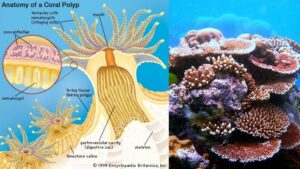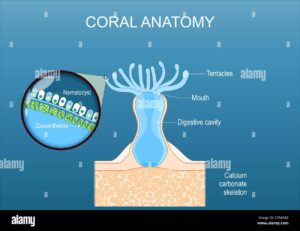Back to: ZOOLOGY 200 Level
It’s great to have you back for another Zoology adventure. Today, we’re going to explore something incredibly beautiful and important in marine biology—Coral Reef Formation. These colourful underwater structures are not just lovely to look at; they also play a major role in ocean life and even human livelihoods. Let’s understand how they come to be!
Coral reef formation
What are coral reefs?
Coral reefs are large underwater structures made from the skeletons of tiny marine animals called coral polyps. These polyps belong to the phylum Cnidaria, the same group as jellyfish and sea anemones. Coral reefs are mostly found in warm, shallow waters and are often referred to as the “rainforests of the sea” because of the incredible biodiversity they support.

Coral polyps live in colonies and produce hard calcium carbonate skeletons. Over many years, these skeletons pile up and form reefs. As old polyps die, new ones grow on top, gradually building the reef upward and outward. This process is slow but steady, and over centuries, it results in the massive reef systems we see today.
How do coral reefs form?
Coral reef formation begins when free-swimming coral larvae, known as planulae, settle on a hard surface under the sea—often rocks or submerged ledges. Once settled, these larvae develop into polyps and start secreting calcium carbonate to build a protective skeleton.
As the polyps reproduce asexually, more polyps are added to the colony. With time, their skeletons join together, forming the base structure of the reef. This colony continues to grow layer by layer as generations of polyps live, build, and die. Coral reefs usually form in clear, sunlit waters where photosynthetic algae, called zooxanthellae, can thrive inside the coral’s tissues. These algae provide energy to the coral through photosynthesis and help speed up calcium carbonate production.
This partnership between coral and algae is one of the key reasons coral reefs are so productive and colourful.
Types of coral reefs
There are three main types of coral reefs based on their shape and location:
Fringing reefs – These grow close to the shoreline of continents or islands. They are the most common type in places like the East African coast.
Barrier reefs – These are separated from the shore by a deeper lagoon. The Great Barrier Reef in Australia is a famous example.
Atolls – Circular or ring-shaped reefs that form around sunken volcanic islands. They enclose a central lagoon and are commonly found in the Indian Ocean.

Importance of coral reefs
Coral reefs are essential to marine life. They provide shelter, food, and breeding grounds for many species of fish and invertebrates. In countries like Nigeria, where fishing is a major livelihood, reefs support both food supply and economic survival.
Reefs also protect coastlines by reducing the force of ocean waves, helping to prevent erosion. Furthermore, coral reefs attract tourists, supporting local economies through ecotourism.
Summary
Coral reefs are built by colonies of coral polyps that secrete calcium carbonate skeletons over time. They grow gradually and form diverse ecosystems that support marine life, protect coastlines, and contribute to local economies. Fringing, barrier, and atoll reefs are the three main types, each unique in structure and location.
Evaluation
- What are coral reefs made of?
- Describe the role of zooxanthellae in coral reef formation.
- Mention the three types of coral reefs and how they differ.
- Why are coral reefs important to both marine life and human communities?
You’ve just discovered the hidden architects of the ocean—corals! Their hard work builds entire ecosystems that benefit us all. Stay inspired and stay curious—Afrilearn is proud to support your journey. Let’s continue building your knowledge in the next lesson!
